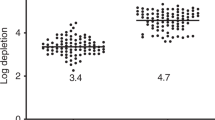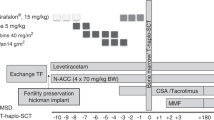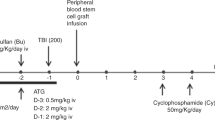Abstract
The objective of this study was to analyze CD34+ cell recovery and T cell depletion (TCD) achieved in CD34+ cell grafts using either immunoadsorption or immunomagnetic methods applied to leukapheresis products from healthy donors. We also wanted to determine the kinetics of engraftment and incidence and severity of graft-versus-host disease (GVHD) after allogeneic transplantation of selected CD34+ cells. HLA-identical sibling donors received G-CSF. After leukapheresis, peripheral blood progenitor cells were selected using immunoadsorption (Ceprate SC) (n = 38) or immunomagnetic (Isolex 300) (n = 24) methods. Sixty-two patients, with a median age of 42 years (range 17–60) diagnosed with hematological malignancies were conditioned with either cyclophosphamide and total body irradiation (n = 43) or busulphan and cyclophosphamide (n = 19). GVHD prophylaxis consisted of cyclosporin A (CsA) and prednisone (n = 48), CsA alone (n = 11) and CsA and methotrexate (n = 3). The median yield and purity of CD34+ cells after the procedure was 65 and 66% with immunoadsorption, and 48 and 86% with immunomagnetic method, respectively. The median number (range) of CD34+ cells infused into the patients was 3.5 × 106/kg (1–9.6). The median number (range) of CD3+ cells administered was 0.4 × 106/kg (0.01–2) using immunoadsorption and 0.14 × 106/kg (0.03–2.5) using immunomagnetic methods. Neutrophil recovery >500 and >1000/μl was achieved at a median (range) of 13 days (8–22) and 14 days (9–31), respectively. Platelets recovered to >20000 and >50000/μl at a median (range) of 13 days (0–128) and 18 days (0–180), respectively. Two patients developed graft failure. Acute GVHD in patients at risk was clinical grade 0 (n = 43), I (n = 8), II (n = 4) and III (n = 1). No patient developed acute GVHD grade IV. Chronic GVHD was limited in two cases and extensive in four cases. The actuarial probability of acute GVHD II–IV was 10% (95% CI, 1–19%), and of extensive chronic GVHD was 12% (95% CI, 11–13%). The cumulative incidence of transplant-related mortality was 12.6%, and this figure was 9% at 6 months. In conclusion, with the immunomagnetic procedure, a lower recovery and higher purity of CD34+ cells, and stronger TCD is obtained as compared to immunoadsorption (P = 0.008, P < 0.0001 and P = 0.0002, respectively). Our results also indicate that allogeneic transplantation of selected CD34+ cells is associated with a very rapid engraftment and with a low incidence of severe GVHD.
This is a preview of subscription content, access via your institution
Access options
Subscribe to this journal
Receive 12 print issues and online access
$259.00 per year
only $21.58 per issue
Buy this article
- Purchase on Springer Link
- Instant access to full article PDF
Prices may be subject to local taxes which are calculated during checkout
Similar content being viewed by others
Author information
Authors and Affiliations
Consortia
Rights and permissions
About this article
Cite this article
Urbano-Ispizua, A., Solano, C., Brunet, S. et al. Allogeneic transplantation of selected CD34+ cells from peripheral blood: experience of 62 cases using immunoadsorption or immunomagnetic technique. Bone Marrow Transplant 22, 519–525 (1998). https://doi.org/10.1038/sj.bmt.1701386
Received:
Accepted:
Published:
Issue Date:
DOI: https://doi.org/10.1038/sj.bmt.1701386
Keywords
This article is cited by
-
Transplantation of CD34+ selected peripheral blood to HLA-identical sibling patients with aplastic anaemia: results from a single institution
Bone Marrow Transplantation (2005)
-
Combined positive and negative cell selection from allogeneic peripheral blood progenitor cells (PBPC) by use of immunomagnetic methods
Bone Marrow Transplantation (2001)
-
Individually adjusted prophylactic donor lymphocyte infusions after CD34-selected allogeneic peripheral blood stem cell transplantation
Bone Marrow Transplantation (2001)
-
Second Transplantation With CD34+ Blood Cells From an HLA-Mismatched Related Donor After Engraftment Failure of Transplanted Cord Blood Cells
International Journal of Hematology (2001)
-
Allogeneic hematopoietic transplantation of CD34+ selected cells from an HLA haplo-identical related donor. A long-term follow-up of 135 patients and a comparison of stem cell source between the bone marrow and the peripheral blood
Bone Marrow Transplantation (2000)



